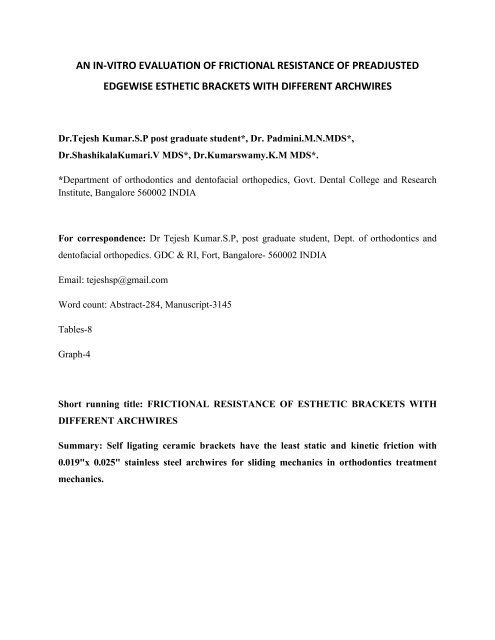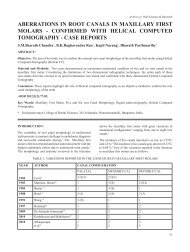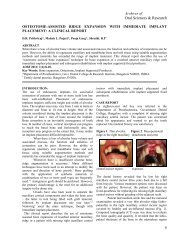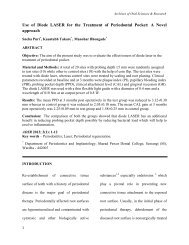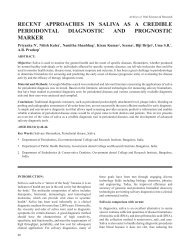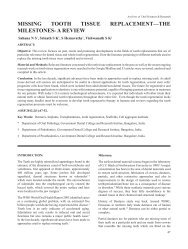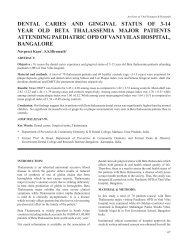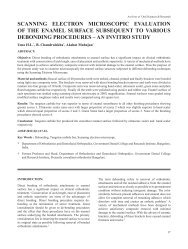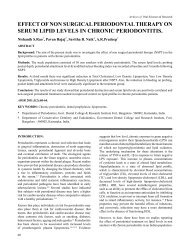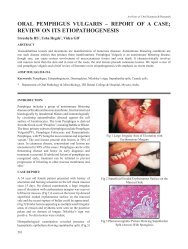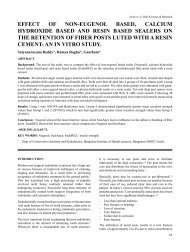AN IN-VITRO EVALUATION OF FRICTIONAL ... - Aosr.co.in
AN IN-VITRO EVALUATION OF FRICTIONAL ... - Aosr.co.in
AN IN-VITRO EVALUATION OF FRICTIONAL ... - Aosr.co.in
Create successful ePaper yourself
Turn your PDF publications into a flip-book with our unique Google optimized e-Paper software.
<strong>AN</strong> <strong>IN</strong>-<strong>VITRO</strong> <strong>EVALUATION</strong> <strong>OF</strong> <strong>FRICTIONAL</strong> RESIST<strong>AN</strong>CE <strong>OF</strong> PREADJUSTED<br />
EDGEWISE ESTHETIC BRACKETS WITH DIFFERENT ARCHWIRES<br />
Dr.Tejesh Kumar.S.P post graduate student*, Dr. Padm<strong>in</strong>i.M.N.MDS*,<br />
Dr.ShashikalaKumari.V MDS*, Dr.Kumarswamy.K.M MDS*.<br />
*Department of orthodontics and dentofacial orthopedics, Govt. Dental College and Research<br />
Institute, Bangalore 560002 <strong>IN</strong>DIA<br />
For <strong>co</strong>rrespondence: Dr Tejesh Kumar.S.P, post graduate student, Dept. of orthodontics and<br />
dentofacial orthopedics. GDC & RI, Fort, Bangalore- 560002 <strong>IN</strong>DIA<br />
Email: tejeshsp@gmail.<strong>co</strong>m<br />
Word <strong>co</strong>unt: Abstract-284, Manuscript-3145<br />
Tables-8<br />
Graph-4<br />
Short runn<strong>in</strong>g title: <strong>FRICTIONAL</strong> RESIST<strong>AN</strong>CE <strong>OF</strong> ESTHETIC BRACKETS WITH<br />
DIFFERENT ARCHWIRES<br />
Summary: Self ligat<strong>in</strong>g ceramic brackets have the least static and k<strong>in</strong>etic friction with<br />
0.019"x 0.025" sta<strong>in</strong>less steel archwires for slid<strong>in</strong>g mechanics <strong>in</strong> orthodontics treatment<br />
mechanics.
Abstract<br />
Background: Friction is a cl<strong>in</strong>ical challenge particularly with slid<strong>in</strong>g mechanics and must be<br />
dealt efficiently to provide orthodontic results. Hence <strong>co</strong>nsider<strong>in</strong>g esthetic demands by the<br />
patient and frictional resistance <strong>in</strong> bracket-archwire, a study was done to know which bracket<br />
archwire <strong>co</strong>mb<strong>in</strong>ation fulfill the esthetic requirement and least friction for slid<strong>in</strong>g mechanics <strong>in</strong><br />
tooth movement.<br />
Material and methods: An <strong>in</strong>-vitro study was carried out to <strong>co</strong>mpare the frictional force<br />
generated between the archwires and bracket slots with simulated retraction of tooth dur<strong>in</strong>g<br />
slid<strong>in</strong>g mechanics. Three types of brackets of preadjusted edgewise appliance MBT Versatile+<br />
with 0.022 ×0.028 <strong>in</strong>ch slot size namely sta<strong>in</strong>less steel brackets, ceramic with metal slot and<br />
ceramic self ligat<strong>in</strong>g brackets and fifty millimeter straight lengths of 0.016" Nit<strong>in</strong>ol,<br />
0.019"x0.025" sta<strong>in</strong>less steel, TMA and epoxy archwires were used. The archwires were ligated<br />
to the <strong>co</strong>nventional bracket with elastomeric module. Each bracket-archwire was bonded on the<br />
jig and mounted on an <strong>in</strong>stron mach<strong>in</strong>e. Frictional resistances of all bracket-archwire<br />
<strong>co</strong>mb<strong>in</strong>ation were tested <strong>in</strong> dry state and at room temperature.<br />
Results: Factorial <strong>AN</strong>OVA revealed that mean and k<strong>in</strong>etic friction of brackets and archwires<br />
were statistically significant with P
<strong>IN</strong>TRODUCTION<br />
The earliest re<strong>co</strong>rded experiments on friction were carried out by the versatile genius<br />
Leonardo da V<strong>in</strong>ci approximately 450 years ago. Ac<strong>co</strong>rd<strong>in</strong>g to Palmer, the reason Leonardo’s<br />
works were never published was related to his methods of writ<strong>in</strong>g. He states that Coulomb and<br />
Mor<strong>in</strong> were credited with the classic works <strong>in</strong> laws of friction. 1<br />
Friction is the resistance to motion when one object moves tangentially aga<strong>in</strong>st<br />
another. A dist<strong>in</strong>ction is made between static frictional force—the smallest force needed to start<br />
the motion—and k<strong>in</strong>etic frictional force—the force needed to resist the slid<strong>in</strong>g motion of one<br />
solid object over another at a <strong>co</strong>nstant speed. For one object to slide aga<strong>in</strong>st the other the force<br />
application must over<strong>co</strong>me the frictional force; higher frictional resistance requires greater<br />
orthodontic forces. 2<br />
When friction prevents the movement of the tooth to which the bracket is attached, friction<br />
can reduce the available force by almost 40%, result<strong>in</strong>g <strong>in</strong> an anchorage loss. Some authors<br />
suggest develop<strong>in</strong>g ceramic brackets with smoother slot surfaces to decrease any possible effects<br />
of static fatigue. Recently, a new ceramic bracket was designed with a metal-l<strong>in</strong>ed archwire slot. 3<br />
Also gold l<strong>in</strong>ers have been placed <strong>in</strong> polycrystall<strong>in</strong>e alum<strong>in</strong>a bracket slots.<br />
Schumacher et al stated that friction was determ<strong>in</strong>ed mostly by the nature of ligation. Selfligat<strong>in</strong>g<br />
brackets were <strong>in</strong>troduced <strong>in</strong> the mid 1930s <strong>in</strong> the form of the Russell attachment, which<br />
was <strong>in</strong>tended to reduce ligation times and improve operator efficiency. Self-ligat<strong>in</strong>g brackets are<br />
ligatureless bracket systems that have a mechanical device built <strong>in</strong>to the bracket to close off the<br />
edgewise slot. From the patient’s perspective, self ligat<strong>in</strong>g brackets are generally smoother, more<br />
<strong>co</strong>mfortable, and easier to clean because of the absence of wire ligature. Reduced chair time is<br />
another significant advantage. 2<br />
Two types of self-ligat<strong>in</strong>g brackets have been developed.<br />
1) Active SL brackets have a spr<strong>in</strong>g clip that presses aga<strong>in</strong>st the archwire, such as the In-<br />
Ovation, SPEED, and Time brackets.<br />
2) Passive SL brackets have a self-ligat<strong>in</strong>g slide that does not press aga<strong>in</strong>st the wire, such as the<br />
Activa, the Tw<strong>in</strong>Lock, Damon SL 3, SmartClip and more recently Clarity SL brackets.
Consider<strong>in</strong>g the esthetic requirements and also least friction essential for slid<strong>in</strong>g<br />
mechanics dur<strong>in</strong>g tooth movement an <strong>in</strong>-vitro study was done to <strong>co</strong>mpare the frictional<br />
resistances among preadjusted edgewise brackets namely sta<strong>in</strong>less steel, esthetic ceramic<br />
brackets with metal slot and ceramic self ligat<strong>in</strong>g brackets hav<strong>in</strong>g 0.022× 0.028 <strong>in</strong>ch slot us<strong>in</strong>g<br />
0.016 <strong>in</strong>ch nickel titanium archwire, 0.019× 0.025 <strong>in</strong>ch sta<strong>in</strong>less steel, TMA and esthetic epoxy<br />
<strong>co</strong>ated sta<strong>in</strong>less steel archwires.<br />
MATERIAL <strong>AN</strong>D METHODS<br />
An <strong>in</strong>-vitro study was carried out to <strong>co</strong>mpare the frictional resistance produced between the<br />
archwires and the bracket slots similar to simulated retraction of tooth dur<strong>in</strong>g slid<strong>in</strong>g mechanics.<br />
S<strong>in</strong>ce metallic archwires do not fulfill the esthetic demands <strong>co</strong>mpletely, epoxy <strong>co</strong>ated esthetic<br />
archwires were also used <strong>in</strong> this study.<br />
Brackets: Three types of brackets were used. Each type <strong>co</strong>nsisted of twenty upper right<br />
premolar MBT brackets hav<strong>in</strong>g 0.022 ×0.028 <strong>in</strong>ch slot size.<br />
Brackets Tip Torque Company<br />
Type 1 MBT sta<strong>in</strong>less steel, Tw<strong>in</strong> bracket Zero -7 Gem<strong>in</strong>i 3M<br />
Type 2 MBT Ceramic-metal slot (Slot is Zero -7 Orm<strong>co</strong> Sawbros Int. Ltd<br />
electroplated with gold)<br />
Type 3 MBT Ceramic-self ligat<strong>in</strong>g. Passive Zero -7 Clarity SL 3M<br />
The Clarity SL bracket is a ceramic version of SmartClip. It is a ceramic bracket with passive<br />
self ligat<strong>in</strong>g mechanism hav<strong>in</strong>g two NiTi clip but does not have a mov<strong>in</strong>g door/slide. When<br />
engag<strong>in</strong>g the archwire <strong>in</strong>to the slot the NiTi clips open and close through elastic deformation.<br />
Hence partial engagement of the archwire to either mesial or distal NiTi clips is possible <strong>in</strong><br />
severely malposed teeth. S<strong>in</strong>ce these brackets have tie w<strong>in</strong>gs <strong>co</strong>nventional ligation is possible<br />
with a feature known as “Active on demand”. This provides the cl<strong>in</strong>ician to augment rotation<br />
<strong>co</strong>rrection and anchorage <strong>co</strong>ntrol.
Archwires: Fifty millimeter straight lengths of the follow<strong>in</strong>g archwires were used.<br />
Archwires<br />
Length Company<br />
1 0.016" nit<strong>in</strong>ol 50 mm Optima<br />
2 0.019"x 0.025" sta<strong>in</strong>less steel 50 mm Optima<br />
3 0.019"x 0.025" Titanium Molybdenum Alloy 50 mm Optima<br />
4 0.019"x 0.025" epoxy <strong>co</strong>ated sta<strong>in</strong>less steel 50 mm Ortho organizer<br />
For sta<strong>in</strong>less steel bracket and ceramic with metal slot bracket, ligation was done with<br />
standardized and <strong>co</strong>nventional elastomeric modules just before start<strong>in</strong>g the test so that the<br />
degradation force of the elastomeric ligation was avoided. The test assembly <strong>in</strong> this study was<br />
similar to the one used by Kapur Wadhwa R, Kwon HK, Close JM. 4 This test assembly mimics<br />
the works carried out by various authors.<br />
The frictional resistance between the bracket and archwire was tested at room temperature<br />
and <strong>in</strong> dry state without us<strong>in</strong>g artificial saliva. Each bracket was tested only once, and each wire<br />
specimen of 50 mm long was drawn through one bracket only, so as to elim<strong>in</strong>ate the <strong>in</strong>fluence of<br />
wear. 4 The total sample size of the experiment was sixty.<br />
A custom made jig of plastic was used to hold the wires parallel to the vertical framework<br />
of the Instron universal test<strong>in</strong>g mach<strong>in</strong>e. The jig measured 10 cm <strong>in</strong> length, 4cm <strong>in</strong> width and had<br />
a thickness of 3 mm.<br />
Each bracket was secured on the jig us<strong>in</strong>g cyanoacrylate adhesive. The straight lengths of<br />
different archwires were ligated to the bracket us<strong>in</strong>g <strong>co</strong>nventional elastomeric modules. The jig<br />
with the different bracket-archwire <strong>co</strong>mb<strong>in</strong>ation was vertically mounted on the Instron universal<br />
test<strong>in</strong>g mach<strong>in</strong>e. The archwire protrud<strong>in</strong>g from the bracket was carefully clamped to the lower<br />
jaws of the moveable crosshead, so that the wire was parallel to the l<strong>in</strong>e scribed on the steel bar and<br />
also to the long axis of the Instron mach<strong>in</strong>e. Each test run lasted for two m<strong>in</strong>ute and the rate of<br />
movement of the wire through the bracket was 0.02 <strong>in</strong>ch / m<strong>in</strong>ute fitted with 10 pound tension<br />
load cell. The static and k<strong>in</strong>etic frictional resistances were re<strong>co</strong>rded <strong>in</strong> grams.<br />
RESULTS: In this experiment two factors <strong>in</strong>fluence friction namely bracket and archwire.<br />
Null Hypotheses:
H 0(a) : There was no significant difference between the different types of brackets.<br />
H 0(b) : There was no significant difference between the different wires.<br />
H 0(c) : The <strong>in</strong>teraction (jo<strong>in</strong>t effect) of brackets and wires were not significant.<br />
Alternate Hypotheses:<br />
H 1(a) : There is a significant difference between the different types of brackets.<br />
H 1(b) : There is a significant difference between the different wires.<br />
H 1(c) : The <strong>in</strong>teraction (jo<strong>in</strong>t effect) of brackets and wires were significant.<br />
Level of significance: α=0.05.<br />
Decision Criterion: We <strong>co</strong>mpare the p-values with the level of significance. If P0.05, we accept the null hypothesis.<br />
If there is a significant difference, we carry out multiple <strong>co</strong>mparisons (post hoc-test) us<strong>in</strong>g<br />
Bonferroni method to f<strong>in</strong>d out among which pair of groups there exist a significant difference.<br />
Statistical technique used: Factorial <strong>AN</strong>OVA<br />
S<strong>in</strong>ce significant difference was found among the different brackets and significant<br />
difference was found among the archwires Alternate hypothesis was accepted. Null hypothesis<br />
was accepted for the <strong>in</strong>teraction of brackets and archwires s<strong>in</strong>ce it was not significant.(Table 4<br />
and 8)<br />
Comparison of Static Friction: (Table 3)<br />
Ceramic-self ligat<strong>in</strong>g bracket and 0.016" round nit<strong>in</strong>ol archwire showed the least static friction<br />
of 0.007 grams with standard deviation of 0.008.<br />
Ceramic-self ligat<strong>in</strong>g bracket and 0.019"x0.025” SS archwire showed the least static friction of<br />
0.019 grams with standard deviation of 0.006 among rectangular wires.<br />
Metal bracket and 0.019"x0.025" TMA archwire showed the highest static friction of 0.365<br />
grams with standard deviation of 0.060 among rectangular wires.<br />
Comparison of k<strong>in</strong>etic Friction: (Table 7)<br />
Ceramic-self ligat<strong>in</strong>g bracket and 0.016" round nit<strong>in</strong>ol archwire showed the least k<strong>in</strong>etic friction<br />
of 0.005 grams with standard deviation of 0.004<br />
Ceramic-self ligat<strong>in</strong>g bracket and 0.019" X 0.025" SS archwire showed the least k<strong>in</strong>etic friction<br />
of 0.020 grams with standard deviation of 0.007 among rectangular wires<br />
Metal bracket and 0.019" X 0.025" epoxy archwire showed the highest k<strong>in</strong>etic friction of 0.343<br />
grams with standard deviation of 0.070 among rectangular wires.
DISCUSSION<br />
The classical laws of friction state that a frictional force is (1) proportional to the force<br />
normally act<strong>in</strong>g on the <strong>co</strong>ntact, (2) <strong>in</strong>dependent of the area of <strong>co</strong>ntact, and (3) <strong>in</strong>dependent of the<br />
slid<strong>in</strong>g velocity. 5 As two surfaces <strong>in</strong> <strong>co</strong>ntact slide aga<strong>in</strong>st each other, two <strong>co</strong>mponents of total<br />
force arise: the frictional force <strong>co</strong>mponent (F) and the normal force <strong>co</strong>mponent (N) perpendicular<br />
to the <strong>co</strong>ntact<strong>in</strong>g surfaces and to the frictional force <strong>co</strong>mponent. Frictional force is directly<br />
proportional to the normal force, such that F =µN, where µ is <strong>co</strong>efficient of friction. 6<br />
The Resistance to Slid<strong>in</strong>g (RS) of an archwire-bracket <strong>co</strong>uple is the <strong>co</strong>mb<strong>in</strong>ed effect of<br />
up to 3 <strong>co</strong>mponents: classical friction (FR), elastic b<strong>in</strong>d<strong>in</strong>g (BI), and/or physical notch<strong>in</strong>g (NO). 7<br />
RS = FR + BI + NO<br />
This study was carried out to test the friction dur<strong>in</strong>g two fundamental therapeutical phases:<br />
(1) level<strong>in</strong>g and align<strong>in</strong>g phase with a superelastic round nickel titanium archwire , and<br />
(2) slid<strong>in</strong>g mechanics on aligned brackets with rectangular archwires of different alloys i.e.<br />
TMA, sta<strong>in</strong>less steel and epoxy.<br />
Among the different wires, NiTi re<strong>co</strong>rded the lowest mean static friction of 0.044 grams.<br />
Highest mean static friction of 0.244 grams was re<strong>co</strong>rded <strong>in</strong> epoxy wire followed by TMA with<br />
0.226 grams and sta<strong>in</strong>less steel wire with 0.135 grams. (Table 1 and Graph 1) The differences<br />
<strong>in</strong> mean static friction re<strong>co</strong>rded <strong>in</strong> the different wires were found to be statistically significant.<br />
NiTi also re<strong>co</strong>rded the lowest mean k<strong>in</strong>etic friction of 0.049 grams. Highest mean k<strong>in</strong>etic<br />
friction of 0.237 grams was re<strong>co</strong>rded <strong>in</strong> epoxy wire, followed by 0.199 grams and 0.109 grams of<br />
k<strong>in</strong>etic friction <strong>in</strong> TMA and sta<strong>in</strong>less steel archwires respectively. (Table 5 and Graph 3) The<br />
differences <strong>in</strong> mean k<strong>in</strong>etic friction re<strong>co</strong>rded <strong>in</strong> the different wires were found to be statistically<br />
significant. The TMA archwires had revealed relatively rough surface due to the <strong>co</strong>ld weld<strong>in</strong>g of<br />
titanium to the rollers dur<strong>in</strong>g manufactur<strong>in</strong>g and also localized sites of <strong>co</strong>ld weld<strong>in</strong>g to the<br />
brackets slot dur<strong>in</strong>g slid<strong>in</strong>g mechanics. These two factors <strong>co</strong>ntribute to the high friction. Because<br />
sta<strong>in</strong>less steel wires do not <strong>co</strong>ld weld or b<strong>in</strong>d to the rollers dur<strong>in</strong>g manufactur<strong>in</strong>g have relatively<br />
smooth surface and hence less <strong>co</strong>efficient of friction. Frictional properties of <strong>co</strong>mposite wires are<br />
high because the re<strong>in</strong>forcement fibers were abrasively worn from the wire surfaces when tests<br />
were <strong>co</strong>nducted at high normal forces or angulations.
Bracket/wire <strong>in</strong>teraction<br />
Lowest mean static friction of 0.05 grams was re<strong>co</strong>rded <strong>in</strong> SLC bracket <strong>co</strong>mpared to the<br />
others. (Table 3 and Graph 2) Highest mean static friction of 0.238 grams was re<strong>co</strong>rded <strong>in</strong> metal<br />
bracket followed by ceramic-metal slot bracket with 0.199grams. The differences <strong>in</strong> mean static<br />
friction re<strong>co</strong>rded <strong>in</strong> the three brackets were found to be statistically significant. Lowest mean<br />
k<strong>in</strong>etic friction of 0.049 grams was re<strong>co</strong>rded <strong>in</strong> SLC bracket <strong>co</strong>mpared to the others (Table 7 and<br />
Graph 4). Highest mean k<strong>in</strong>etic friction of 0.227 grams and 0.170 grams was re<strong>co</strong>rded <strong>in</strong> metal<br />
bracket followed by ceramic-metal slot bracket respectively. The differences <strong>in</strong> mean k<strong>in</strong>etic<br />
friction re<strong>co</strong>rded <strong>in</strong> the three brackets were found to be statistically significant. The passive<br />
ceramic self ligat<strong>in</strong>g bracket showed least resistance to all the wires s<strong>in</strong>ce there was no ligation<br />
force on the bracket-archwire <strong>co</strong>mb<strong>in</strong>ation. F<strong>in</strong>ally, the static frictional force was greater than the<br />
k<strong>in</strong>etic force <strong>in</strong> all bracket-archwire <strong>co</strong>mb<strong>in</strong>ations and supports the study done by Down<strong>in</strong>g and<br />
McCabe. 8<br />
CONCLUSION<br />
This is an <strong>in</strong>-vitro study that was carried out to <strong>co</strong>mpare the static and k<strong>in</strong>etic<br />
frictional resistance of ceramic self ligat<strong>in</strong>g bracket, ceramic bracket with metal slot, metal<br />
bracket with 0.016" nit<strong>in</strong>ol and 0.019"x0.025" sta<strong>in</strong>less steel, TMA and epoxy <strong>co</strong>ated archwires.<br />
Friction produced by the metal bracket with <strong>co</strong>nventional ligation was the <strong>co</strong>ntrol group <strong>in</strong> the<br />
study. The results of the study were as follows<br />
• The k<strong>in</strong>etic and static friction of ceramic self ligat<strong>in</strong>g bracket were least with all archwire<br />
<strong>co</strong>mb<strong>in</strong>ations <strong>in</strong> <strong>co</strong>mparison to the ceramic bracket with metal slot and metal bracket.<br />
• The k<strong>in</strong>etic and static friction of epoxy <strong>co</strong>ated archwire was the highest with all the<br />
bracket <strong>co</strong>mb<strong>in</strong>ations <strong>co</strong>mpared to other archwires.<br />
• Metal bracket with 0.019"x0.025"TMA and epoxy archwire showed the highest friction.<br />
• The static and k<strong>in</strong>etic friction of ceramic self ligat<strong>in</strong>g bracket was least with<br />
0.019"x0.025" sta<strong>in</strong>less steel archwire.<br />
• 0.016" Nit<strong>in</strong>ol archwire showed least static and k<strong>in</strong>etic frictional resistance with ceramic<br />
self ligat<strong>in</strong>g bracket.
• 0.016" Nit<strong>in</strong>ol archwire showed highest static frictional resistance with ceramic–metal<br />
slot bracket and highest k<strong>in</strong>etic frictional resistance with metal bracket.<br />
• Round wire had lesser frictional resistance than rectangular wire. Hence the cross section<br />
of the archwire affects the frictional resistance with bracket.<br />
• Static frictional force was <strong>co</strong>mparatively more than the k<strong>in</strong>etic frictional force with all the<br />
bracket-archwire <strong>co</strong>mb<strong>in</strong>ations.<br />
Self-ligat<strong>in</strong>g ceramic brackets not only make archwire placement more <strong>co</strong>nvenient and<br />
secure, from patient po<strong>in</strong>t of view it is <strong>co</strong>mfortable and esthetically acceptable and also have<br />
lower k<strong>in</strong>etic frictional forces than <strong>co</strong>nventional brackets. These features can be substantial<br />
advantages for orthodontists who use slid<strong>in</strong>g mechanics. The advantages of self-ligat<strong>in</strong>g brackets<br />
and different archwires with less friction should be borne <strong>in</strong> m<strong>in</strong>d when <strong>co</strong>nsider<strong>in</strong>g their use.<br />
References<br />
1. Garner LD, Allai WW, Moore BK. A <strong>co</strong>mparison of frictional forces dur<strong>in</strong>g simulated<br />
can<strong>in</strong>e retraction of a <strong>co</strong>nt<strong>in</strong>uous edgewise arch wire. Am J Orthod Dentofacial Orthop<br />
1986 Sep; 90(3): 199-203.<br />
2. Cacciafesta V, Sfondr<strong>in</strong>i MF, Ricciardi A, Scribante A, Klersy C, Auricchio F.<br />
Evaluation of friction of sta<strong>in</strong>less steel and esthetic self-ligat<strong>in</strong>g brackets <strong>in</strong> various<br />
bracket-archwire <strong>co</strong>mb<strong>in</strong>ations. Am J Orthod Dentofacial Orthop. 2003; 124: 395–402.<br />
3. Nishio C, da Motta AF, Elias CN, Mucha JN. In vitro evaluation of frictional forces<br />
between archwires and ceramic brackets. Am J Orthod Dentofacial Orthop 2004; 125:<br />
56-64.<br />
4. Kapur Wadhwa R, Kwon HK, Close JM. Frictional resistance of different bracket-wire<br />
<strong>co</strong>mb<strong>in</strong>ations. Aust Orthod J. 2004 May; 20(1): 25-30.<br />
5. Tidy DC. Frictional forces <strong>in</strong> fixed appliances. Am J Orthod Dentofacial Orthop 1989<br />
Sep; 96(3): 249-54.<br />
6. Darryl V. Smith, P. Emile Rossouw, and Phillip Watson. Quantified Simulation of<br />
Can<strong>in</strong>e Retraction. Sem<strong>in</strong> Orthod. 2003,Dec:262-280<br />
7. Thorstenson GA, Kusy RP. Resistance to slid<strong>in</strong>g of self-ligat<strong>in</strong>g brackets versus<br />
<strong>co</strong>nventional sta<strong>in</strong>less steel tw<strong>in</strong> brackets with se<strong>co</strong>nd-order angulation <strong>in</strong> the dry and wet<br />
(saliva) states. Am J Orthod Dentofacial Orthop. 2001 Oct; 120(4):361-70.
8. Down<strong>in</strong>g A, McCabe J, Gordon P. A study of frictional forces between orthodontic<br />
brackets and archwires. Br J Orthod. 1994 Nov; 21(4):349-57.<br />
9. Berger JL. The <strong>in</strong>fluence of the SPEED bracket's self-ligat<strong>in</strong>g design on force levels <strong>in</strong><br />
tooth movement, a <strong>co</strong>mparative <strong>in</strong> vitro study. Am J Orthod Dentofacial Orthop<br />
1990 Mar; 97(3): 219-28<br />
10. Kapila S, Angolkar PV, Duncanson MG Jr, Nanda RS. Evaluation of friction between<br />
edgewise sta<strong>in</strong>less steel brackets and orthodontic wires of four alloys. Am J Orthod<br />
Dentofacial Orthop. 1990 Aug; 98(2): 117-26.<br />
11. Kusy RP, Whitley JQ. Coefficient of friction for archwires <strong>in</strong> sta<strong>in</strong>less steel and<br />
polycrystall<strong>in</strong>e alum<strong>in</strong>a bracket slots. I. The dry state Am J Orthod Dentofacial Orthop.<br />
1990 Oct; 98(4):300-12.<br />
12. Tanne K, Matsubara S, Shibaguchi T, Sakuda M. Wire friction from ceramic brackets<br />
dur<strong>in</strong>g simulated can<strong>in</strong>e retraction. Angle Orthod. 1991 W<strong>in</strong>ter; 61(4):285-90.<br />
13. James R. Bednar, Gary W. Gruedeman, and James L. Sandrick A Comparative study of<br />
frictional forces between orthodontic brackets and arch wires. Am J Orthod Dentofac<br />
Orthop. 1991; 100: 513-22<br />
14. Taylor NG, Ison K. Frictional resistance between orthodontic brackets and archwires <strong>in</strong><br />
the buccal segments. Angle Orthod 1996; 66(3): 215-22.<br />
15. Dickson J, Jones S. Frictional characteristics of a modified ceramic bracket. J Cl<strong>in</strong><br />
Orthod. 1996 Sep; 30(9):516-8.<br />
16. Read-Ward GE, Jones SP, Davies EH. A <strong>co</strong>mparison of self-ligat<strong>in</strong>g and <strong>co</strong>nventional<br />
orthodontic bracket systems. Br J Orthod 1997 Nov; 24(4): 309-17<br />
17. Kapur R, S<strong>in</strong>ha PK, Nanda RS. Frictional resistance of the Damon SL bracket. J Cl<strong>in</strong><br />
Orthod. 1998 Aug; 32(8):485-9.<br />
18. Pizzoni L, Ravnholt G, Melsen B. Frictional forces related to self-ligat<strong>in</strong>g<br />
brackets. Eur J Orthod 1998 Jun; 20(3): 283-91.<br />
19. Braun S, Blueste<strong>in</strong> M, Moore BK, Benson G. Friction <strong>in</strong> perspective. Am J<br />
Orthod Dentofacial Orthop 1999 Jun; 115(6): 619-27.<br />
20. Burrow SJ. Can<strong>in</strong>e retraction rate with self-ligat<strong>in</strong>g brackets vs <strong>co</strong>nventional edgewise<br />
brackets. Angle Orthod. 2010 Jul;80(4):438-45.
TABLE 1: Mean static friction (grams) re<strong>co</strong>rded <strong>in</strong> the brackets<br />
Bracket Mean SD M<strong>in</strong>imum Median Maximum<br />
Metal 0.238 0.146 0.030 0.237 0.452<br />
Ceramic-metal 0.199 0.163 0.029 0.145 0.650<br />
SLC 0.050 0.058 0.001 0.028 0.220<br />
SLC-self ligat<strong>in</strong>g ceramic, SD-standard deviation<br />
TABLE 2: Mean static friction (grams) re<strong>co</strong>rded <strong>in</strong> the wires<br />
Wire Mean SD M<strong>in</strong> Median Max<br />
NiTi 0.016” 0.044 0.031 0.001 0.050 0.082<br />
SS 0.019”x0.025” 0.135 0.163 0.014 0.111 0.650<br />
TMA .019”x0.025” 0.226 0.166 0.028 0.183 0.518<br />
Epoxy 0.019”x0.025” 0.244 0.124 0.056 0.244 0.452<br />
NiTi-nit<strong>in</strong>ol, SS-sta<strong>in</strong>less steel, TMA-titanium molybdenum alloy,<br />
TABLE 3: Mean static friction (grams) of bracket-archwire <strong>co</strong>mb<strong>in</strong>ation<br />
Bracket Wire Mean SD M<strong>in</strong> Median Max<br />
NiTi 0.054 0.020 0.030 0.056 0.080<br />
Metal SS 0.175 0.050 0.129 0.157 0.258<br />
TMA 0.365 0.060 0.299 0.344 0.435<br />
Epoxy 0.357 0.098 0.215 0.369 0.452<br />
Ceramic- NiTi 0.070 0.013 0.050 0.069 0.082<br />
SS 0.210 0.254 0.029 0.111 0.650<br />
metal slot TMA 0.266 0.163 0.130 0.183 0.518<br />
Epoxy 0.248 0.079 0.121 0.256 0.333<br />
NiTi 0.007 0.008 0.001 0.004 0.020<br />
SLC SS 0.019 0.006 0.014 0.020 0.028<br />
TMA 0.047 0.029 0.028 0.037 0.099<br />
Epoxy 0.126 0.067 0.056 0.123 0.220<br />
┼ denotes significance<br />
TABLE 4: <strong>AN</strong>OVA -Comparison of Static Friction<br />
Source df Sum of Squares Mean F P-Value<br />
Bracket 2 0.392 0.196 19.840
TABLE 5: Mean k<strong>in</strong>etic friction (grams) re<strong>co</strong>rded <strong>in</strong> different brackets<br />
Bracket Mean SD M<strong>in</strong> Median Max<br />
Metal 0.227 0.125 0.051 0.229 0.412<br />
Ceramic-metal 0.170 0.118 0.038 0.131 0.488<br />
SLC 0.049 0.057 0.001 0.026 0.205<br />
TABLE 6: Mean k<strong>in</strong>etic friction (grams) re<strong>co</strong>rded <strong>in</strong> the wires:<br />
Wire Mean SD M<strong>in</strong> Median Max<br />
NiTi 0.016" 0.049 0.038 0.001 0.058 0.136<br />
SS 0.019"x0.025" 0.109 0.079 0.013 0.115 0.242<br />
TMA 0.019"x0.025" 0.199 0.156 0.014 0.149 0.488<br />
Epoxy 0.019"x0.025" 0.237 0.113 0.060 0.243 0.412<br />
TABLE 7: Mean k<strong>in</strong>etic friction (grams) of different bracket-archwire <strong>co</strong>mb<strong>in</strong>ations<br />
Bracket Wire Mean SD M<strong>in</strong> Median Max<br />
NiTi 0.079 0.033 0.051 0.069 0.136<br />
Metal SS 0.173 0.048 0.109 0.172 0.242<br />
TMA 0.314 0.091 0.226 0.292 0.411<br />
Epoxy 0.343 0.070 0.245 0.359 0.412<br />
Ceramic NiTi 0.064 0.008 0.057 0.063 0.076<br />
SS 0.133 0.063 0.038 0.130 0.195<br />
-metal slot TMA 0.242 0.161 0.117 0.149 0.488<br />
Epoxy 0.241 0.089 0.104 0.243 0.348<br />
NiTi 0.005 0.004 0.001 0.003 0.010<br />
SLC SS 0.020 0.007 0.013 0.018 0.028<br />
TMA 0.042 0.031 0.014 0.031 0.092<br />
Epoxy 0.128 0.055 0.060 0.140 0.205<br />
TABLE 8: <strong>AN</strong>OVA- Comparison of K<strong>in</strong>etic Friction<br />
Source df Sum of Squares Mean ss F P-Value<br />
Bracket 2 0.332 0.166 34.016
Ma<strong>in</strong> Effects Plot (fitted means) for Static Friction<br />
Interaction Plot (fitted means) for Static Friction<br />
0.25<br />
Bracket<br />
Wire<br />
0.4<br />
Bracket<br />
Ceramic<br />
Metal<br />
SLC<br />
Mean of Static Friction<br />
0.20<br />
0.15<br />
0.10<br />
Mean<br />
0.3<br />
0.2<br />
0.1<br />
0.05<br />
Ceramic<br />
Metal<br />
SLC<br />
Epoxy<br />
NiTi<br />
SS<br />
TMA<br />
0.0<br />
Epoxy<br />
NiTi<br />
Wire<br />
SS<br />
TMA<br />
GRAPH 1 GRAPH 2<br />
Ma<strong>in</strong> Effects Plot (fitted means) for K<strong>in</strong>etic Friction<br />
Interaction Plot (fitted means) for K<strong>in</strong>etic Friction<br />
0.25<br />
Bracket<br />
Wire<br />
0.35<br />
0.30<br />
Bracket<br />
Ceramic<br />
Metal<br />
SLC<br />
Mean of K<strong>in</strong>etic Friction<br />
0.20<br />
0.15<br />
0.10<br />
Mean<br />
0.25<br />
0.20<br />
0.15<br />
0.10<br />
0.05<br />
0.05<br />
Ceramic<br />
Metal<br />
SLC<br />
Epoxy<br />
NiTi<br />
SS<br />
TMA<br />
0.00<br />
Epoxy<br />
NiTi<br />
Wire<br />
SS<br />
TMA<br />
GRAPH 3 GRAPH 4


